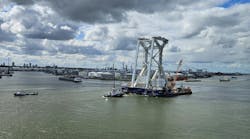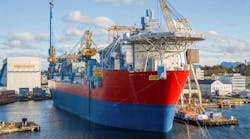One of the key advantages to oil as an energy source is its portability. Reserves identified anywhere in the world can be developed on site, loaded into a tanker, and shipped where they will command the best price. While there are a number of advantages to natural gas, portability is not one of them. Gas can be compressed and piped to market, but for any type of long-range transportation, matters become complicated and expensive.
For the vast majority of remote fields, gas discoveries are not considered commercial. The gas is either reinjected or flared. In some cases, where the gas reserves are large enough and close enough to shore, LNG is an export option. This complex process converts the gas to a liquid state by super cooling it to -260° F. The liquefied gas is then loaded on a specially designed tanker that keeps it cold until it reaches the market where it is regasified.
The key that makes this expensive process profitable is the amount of gas that can be transported. Much like oil, a tanker full of LNG enjoys an economy of scale so that each voyage on these specialized ships pays off. The plants, which process gas into LNG, are quite expensive and have a large footprint. This requires a long-term commitment by the exporter. Because the LNG requires special handling on both the delivery and receiving end, there are a finite number of ports where the fuel is accepted, which somewhat limits the demand for LNG. At the same time, there are a limited number of specialized tankers to transport this product.
An alternative process for delivering gas to distant markets is compressed natural gas (CNG). As the name suggests, this process involves compressing the gas to 1,500 psi and lowering the temperature to -10° F. The gas is transported in its compressed state onboard tankers. The tankers deliver the gas to a specialized receiving port where it is then decompressed. Keeping the gas in such a compressed state requires a honeycomb of piping be built into the tankers. This is not only a specialized design, but it results in a heavy tanker that is expensive to operate.
Because the gas is not compressed to the point of being in a liquid state, a CNG tanker cannot transport as much natural gas as an LNG tanker of the same size. So far, this has made LNG the preferred option. Another consideration is the distance the tankers travel. Because the CNG vessel is so heavy, it is not economic to carry CNG over long distances. CNG would thus be a mid-range solution somewhere between a pipeline and LNG. Estimates vary, but the range of such tankers is typically pegged at around 2,000 mi. Still, the volume of CNG transported has always been the sticking point because it just has not been economical.
That may be in the early stages of changing. It seems that if the gas price stays high enough long enough, a variety of novel transportation solutions start to look viable, including CNG. With demand for natural gas growing across the US and available reserves down, there is already an increased interest in LNG.
Large gas reserves recently discovered offshore Eastern Canada have renewed interest in CNG. If the technical and economic challenges could be overcome, CNG could be used to transport this gas down to the US in a classic CNG scenario. The distance is too great for a pipeline to be affordable, and not great enough to justify the LNG process. Some companies are already looking at building specialized tankers for this solution.
Looking at even broader markets, it will take much of the world's LNG capacity to satisfy China's growing need for energy. This sleeping giant is already the world's third largest consumer of oil, though the majority of its energy still comes from coal. If China's economic development continues, the growth will be seen mainly in urbanized areas where natural gas and oil are the preferred energy sources.
Some of this increased demand will be met by neighboring Russia. Plans are already in the offing to build a pipeline from the Irkutsk area of Siberia, but it is LNG that will open up a variety of sources to feed China gas, including Australia. Recognizing this, the Chinese national oil company recently announced a major LNG receiving facility, aimed at Australian production. With China using much of the world's LNG fleet, there may be increased opportunity to give CNG a try. Clearly pipelines and now LNG seem to be the preferred method of transportation for gas, but there is no denying that a mid-range solution is needed to cover gaps between the two. If gas prices remain strong and demand continues to grow, it is likely that a new technology will emerge to fill this gap.
Readers wishing to respond to issues presented on this page or elsewhere in Offshore, or offer authored articles or article suggestions, should contact the editor by email ([email protected]) or fax (1-713-963-6296).




